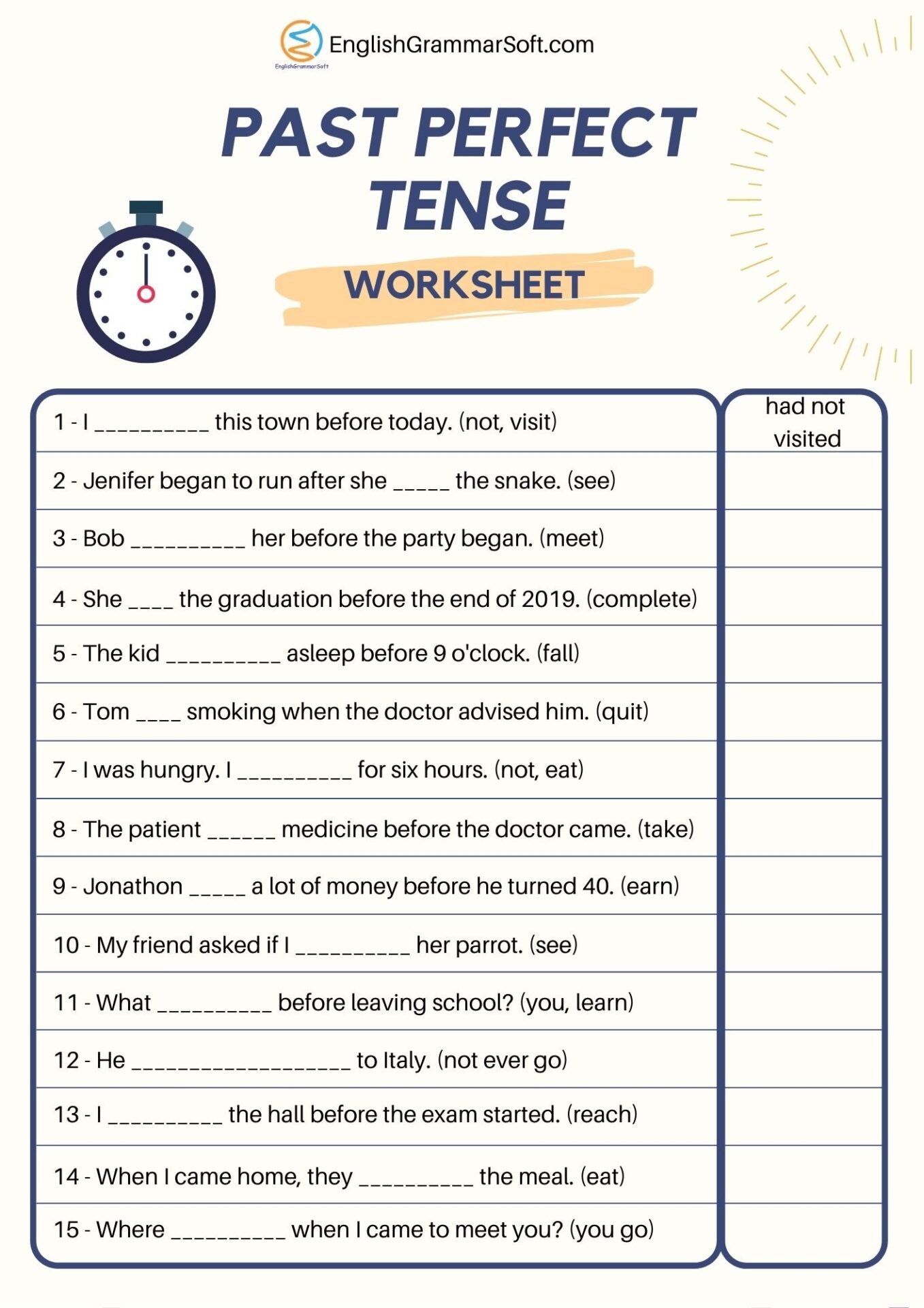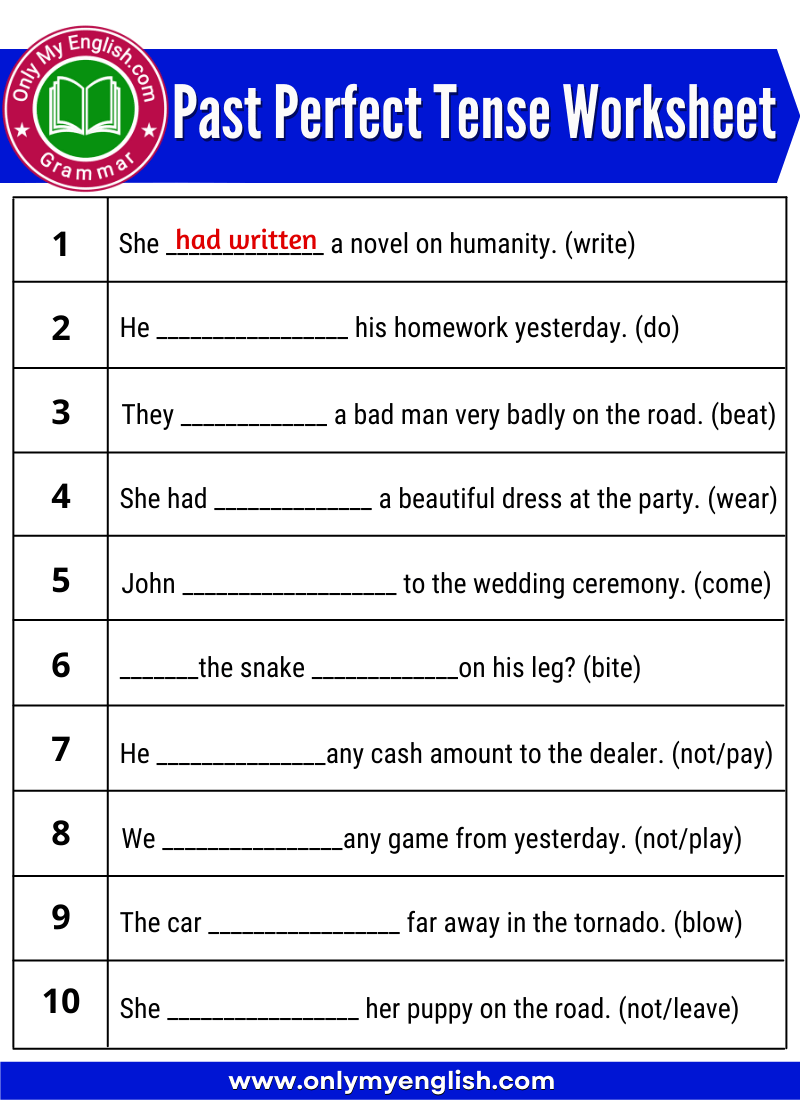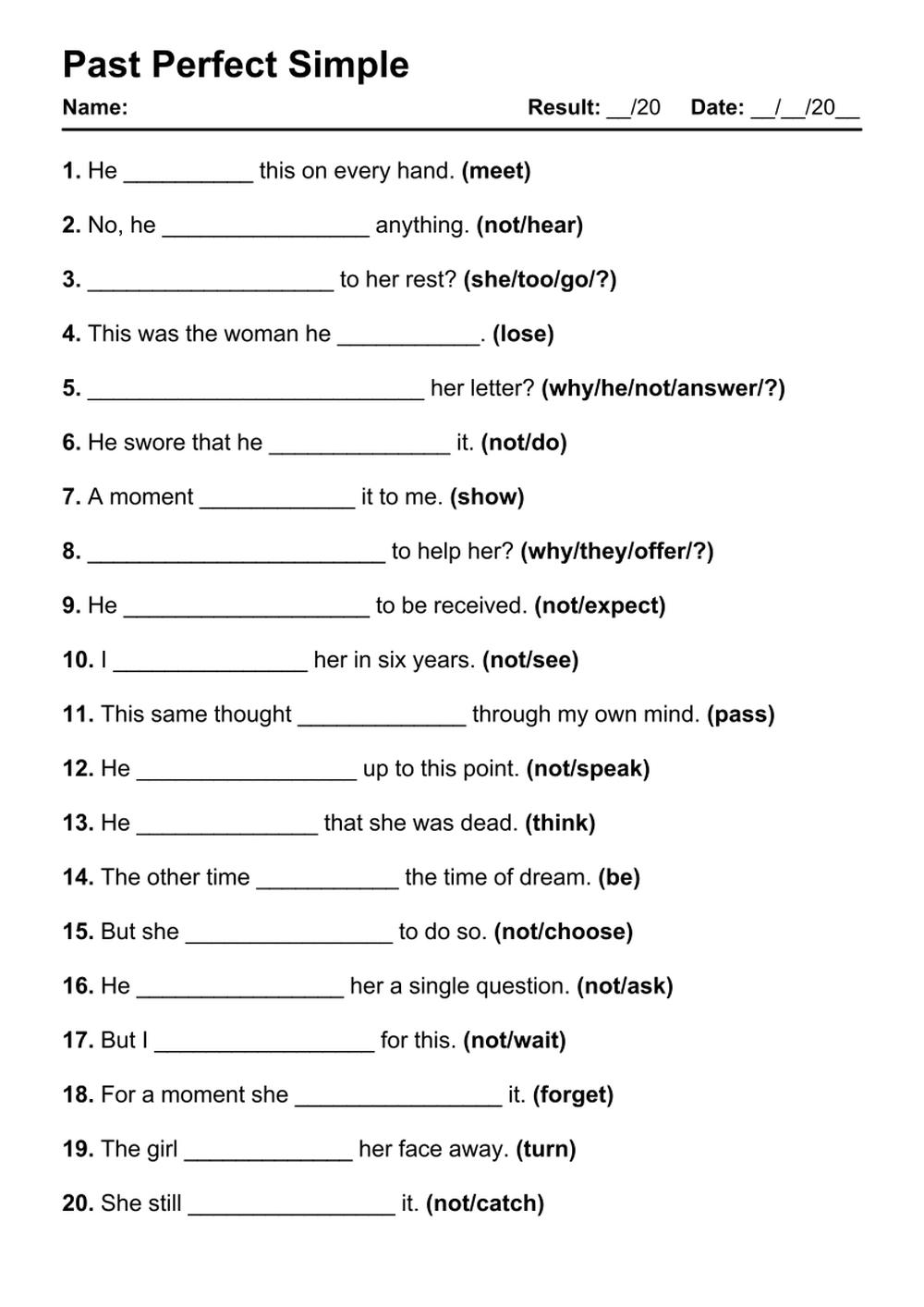
Mastering Time Travel in Grammar: The Power of Grammar Worksheets: Past Perfect Tense
In the intricate tapestry of the English language, tenses serve as the threads that weave together actions, events, and states across different points in time. Among these, the Past Perfect Tense holds a unique and often challenging position, allowing us to refer to an action that occurred before another action in the past. It’s the grammatical equivalent of a flashback, providing crucial context and clarity in narratives. For many learners, both native and non-native, mastering this tense requires more than just memorizing rules; it demands consistent, targeted practice. This is where the invaluable tool of Grammar Worksheets: Past Perfect Tense comes into play.
Unpacking the Past Perfect Tense: A Quick Recap
Before diving into the utility of worksheets, let’s briefly revisit the Past Perfect Tense. It is formed using "had" followed by the past participle (V3) of the main verb (e.g., had eaten, had gone, had studied). Its primary function is to indicate an action that was completed before another action or point in time in the past.

Consider these examples:

- "By the time I arrived, she had already left." (Her leaving happened before my arrival.)
- "He had finished his homework before he went out to play." (Finishing homework happened before going out.)
- "They had never seen such a beautiful sunset until they visited Bali." (Not seeing the sunset happened before visiting Bali.)



The challenge often arises in distinguishing it from the Simple Past or Present Perfect, or in correctly applying it in complex sentences involving multiple past actions. This is precisely where structured practice, facilitated by well-designed Grammar Worksheets: Past Perfect Tense, becomes indispensable.
Why Worksheets Are Essential for Grammatical Mastery
In an age of interactive apps and digital learning platforms, the humble worksheet might seem old-fashioned. However, its enduring effectiveness is undeniable. Worksheets provide a tangible, focused environment for learning and reinforcement, offering several key benefits:

- Active Engagement and Recall: Unlike passively reading a grammar rule, completing a worksheet demands active engagement. Learners must recall the rule, apply it to a specific context, and formulate the correct answer. This active recall strengthens memory pathways far more effectively than passive reception.
- Immediate Application: Worksheets bridge the gap between theoretical knowledge and practical application. They provide scenarios where the learner must immediately put their understanding of the Past Perfect Tense into practice, solidifying their comprehension.
- Identification of Weaknesses: As learners work through exercises, they inevitably encounter areas where they struggle. This self-identification of weak spots is crucial for targeted improvement. A student might consistently confuse the Past Perfect with the Simple Past, indicating a specific area for further review.
- Structured Repetition: Repetition is key to mastering any skill, and grammar is no exception. Worksheets offer a structured way to repeat grammatical patterns and rules until they become second nature. This "muscle memory" for grammar is vital for fluent and accurate communication.
- Self-Paced Learning: Learners can complete worksheets at their own pace, taking as much time as needed to understand each concept before moving on. This flexibility is particularly beneficial for diverse learning styles and schedules.
- Tangible Progress: Completing a worksheet provides a sense of accomplishment and tangible evidence of progress, which can be highly motivating.



Crafting Effective Grammar Worksheets: Past Perfect Tense
Not all worksheets are created equal. An effective Grammar Worksheets: Past Perfect Tense should be more than just a list of sentences to fill in. It should incorporate a variety of exercise types, cater to different learning stages, and provide clear instructions and answers.
Here are essential components and exercise types for comprehensive Past Perfect worksheets:
1. Fill-in-the-Blanks / Sentence Completion:
These are foundational. Learners are given sentences with a blank space and a verb in its base form, requiring them to convert it to the Past Perfect.
- Example: By the time we arrived, they __ (eat) all the cake.
- Purpose: Reinforces the "had + V3" structure and basic application.
2. Sentence Transformation / Combination:
This type challenges learners to combine two simple past sentences into one complex sentence using the Past Perfect to show sequence.
- Example: I finished my work. Then I went to the park. -> After I ___ (finish) my work, I went to the park.
- Purpose: Develops understanding of the temporal relationship between two past actions.
3. Error Correction:
Learners are presented with sentences containing grammatical errors related to the Past Perfect (e.g., wrong auxiliary, wrong participle form, or incorrect tense usage in context) and must identify and correct them.
- Example: She had went to the store before I called her. (Correction: had gone)
- Purpose: Sharpens analytical skills and attention to detail, reinforcing correct forms.
4. Contextualized Exercises / Story Completion:
Instead of isolated sentences, learners complete a short narrative or dialogue using the Past Perfect where appropriate. This helps them understand the tense’s function in a real-world context.
- Example: "I felt lost when I reached the station. My train __ (already leave) and I __ (forget) my wallet at home."
- Purpose: Encourages contextual understanding and natural application, moving beyond rote memorization.
5. Question Formation / Answering:
Learners practice forming questions using the Past Perfect (e.g., "Had you eaten before you left?") and providing appropriate answers.
- Purpose: Develops conversational fluency and reinforces the interrogative structure.
6. Multiple Choice:
Offering choices can be helpful for beginners or as a quick assessment tool, but should not be the sole exercise type.
- Example: By the time the police arrived, the thieves __. (a) escaped (b) had escaped (c) were escaping
- Purpose: Good for quick checks of understanding, but less active than other types.
7. Creative Writing Prompts:
Learners are given a scenario or a picture and asked to write a short paragraph or story incorporating the Past Perfect Tense.
- Example: "Describe a time you were late for an important event. What had happened before you were late?"
- Purpose: Encourages free production and deeper understanding of when and why to use the tense.
Benefits for Different Learners and Educators
Grammar Worksheets: Past Perfect Tense are versatile tools that benefit various stakeholders in the learning process:
- For Students (ESL/EFL and Native Speakers): They provide structured practice, build confidence, help identify and correct common errors, and reinforce the rules for accurate communication. They are particularly vital for non-native speakers struggling with the nuances of English tenses.
- For Teachers: Worksheets are excellent resources for classroom activities, homework assignments, quizzes, and assessments. They allow teachers to gauge student comprehension, provide targeted feedback, and differentiate instruction based on individual needs. Ready-made Grammar Worksheets: Past Perfect Tense save preparation time, allowing educators to focus more on teaching and less on material creation.
- For Self-Learners: For individuals studying independently, worksheets with answer keys are invaluable. They offer a self-assessment tool, allowing learners to check their understanding immediately and learn from their mistakes without needing a tutor.
Maximizing the Impact of Grammar Worksheets: Past Perfect Tense
To truly leverage the power of these worksheets, consider these strategies:
- Consistency is Key: Regular, even short, practice sessions are more effective than infrequent, long ones. Incorporate worksheets into your learning routine.
- Review Mistakes Thoroughly: Don’t just check the answers and move on. Understand why an answer was wrong. Re-read the relevant grammar rule or examples.
- Combine with Other Methods: Worksheets are powerful, but they shouldn’t be the only learning method. Complement them with reading (to see the tense in context), listening (to hear it used naturally), and speaking/writing (to actively produce it).
- Create Your Own Sentences: After completing a worksheet, challenge yourself to create 5-10 original sentences using the Past Perfect Tense. This active generation reinforces learning.
- Seek Feedback: If possible, have a teacher, tutor, or fluent speaker review your completed worksheets or your self-created sentences for further feedback.
- Understand the "Why": Beyond just knowing how to form the Past Perfect, strive to understand why it’s used in specific situations. What narrative purpose does it serve? This deeper comprehension leads to more natural and accurate usage.
Conclusion
The Past Perfect Tense, while sometimes daunting, is a cornerstone of advanced English communication, enabling speakers and writers to convey complex temporal relationships with precision. The journey to mastering this tense is greatly facilitated by dedicated practice, and few tools are as effective in this regard as well-designed Grammar Worksheets: Past Perfect Tense. They offer a structured, active, and self-paced approach to reinforce learning, identify weaknesses, and build the confidence necessary for fluent and accurate English usage. Whether you are a student striving for grammatical excellence, a teacher seeking effective resources, or a self-learner on a quest for mastery, embracing the power of Grammar Worksheets: Past Perfect Tense is a strategic step towards achieving your linguistic goals. They are not merely exercises; they are pathways to clearer communication and deeper understanding of the English language.
